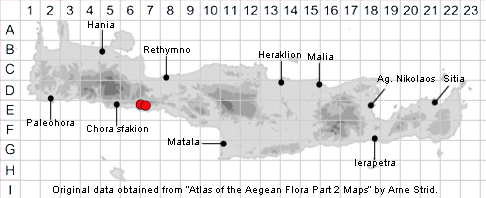SPECIES DESCRIPTION
PETRORHAGIA FASCICULATA
Family and Genus:- See- CARYOPHYLLACEAE/Sect. PETRORHAGIA
Common Names:- None
Synonyms:- Gypsophila fasciculata, Saponaria fasciculata, Tunica fasciculata.
Meaning:- Petrorhagia (Gr) Rock-bursting.
Fasciculata (L) Formed of, or growing in, bundles or clusters.
General description:- Slightly woody-based perennial.
Stems:-
1) 15-30 cm. slender, sparingly branched. patently glandular-pubescent below,
glabrous above.
Leaves:-
1) Cauline, small, erect, 1-veined, rarely up to 5-veined.
Flowers:-
1) Usually in terminal clusters of 2-10.
2) Bracts, not concealing the calyx, rather narrow, membranous, mucronate.
3) Calyx, 2·5-5·5 mm, pubescent or sparsely hirsute, sometimes glandular.
a) teeth, 1-veined, acute or subobtuse.
4) Petals, 3.5-6 mm, linear-spathulate, emarginate, white or pale yellow.
Fruit:-
1) Seeds, small (0.6-1. mm), without thickened margins, reticulate to minutely
tuberculate.
Key features:-
1) Inflorescence, often capitate or fasciculate.
2) Bracts, usually distinctly shorter than the calyx.
3) Stem, usually much-branched, glandular-pubescent, at least at the base.
4) Calyx teeth, ± triangular, acute or subobtuse, 1-veined.
5) Seeds, c. 1 mm, blackish-brown, ± tuberculate.
Habitat:- Gravelly slopes in gorges, 60-120 m (Crete), elsewhere on rocky
limestone slopes at 0-900-1500) m.
Distribution:- Only recently reported from a small area in SW Crete; otherwise
restricted to the Ionian Islands, NW Peloponnisos and the W part of the Greek
mainland.
Flowering time:- Apr-July, sometimes later.
Photos by:- Currenlly none available
